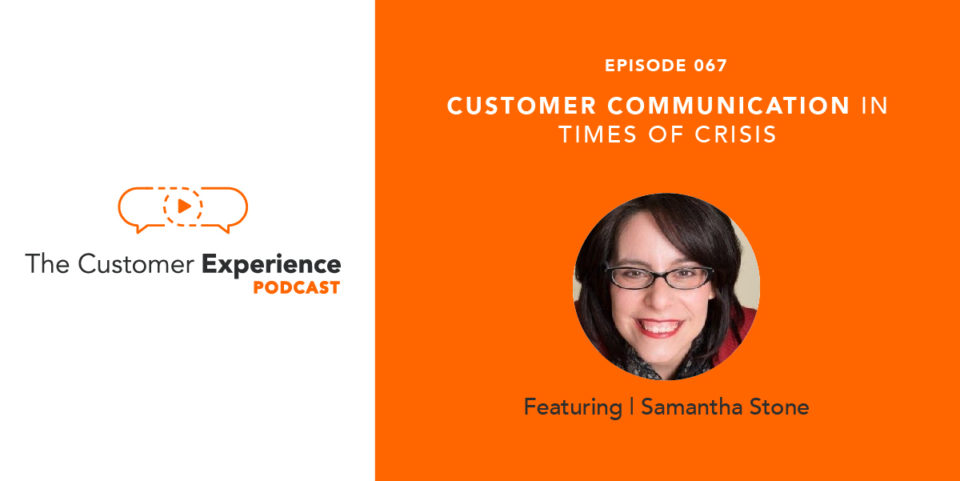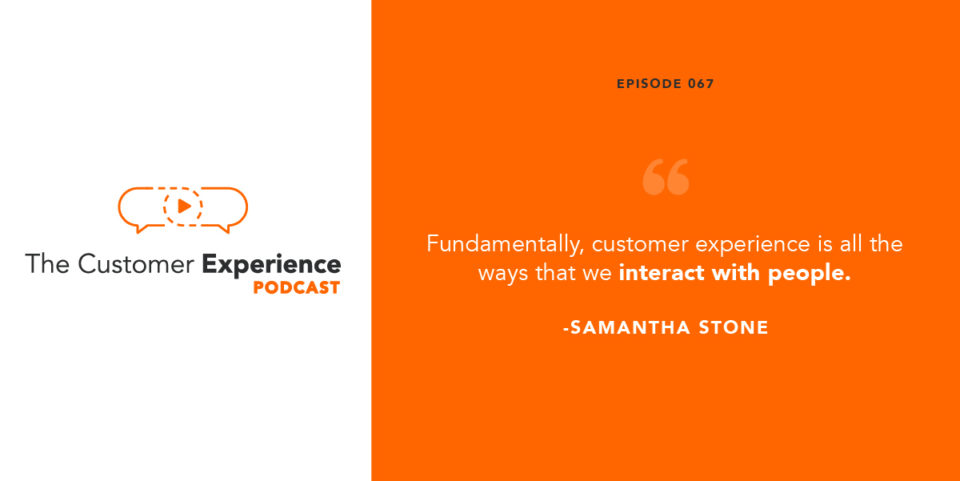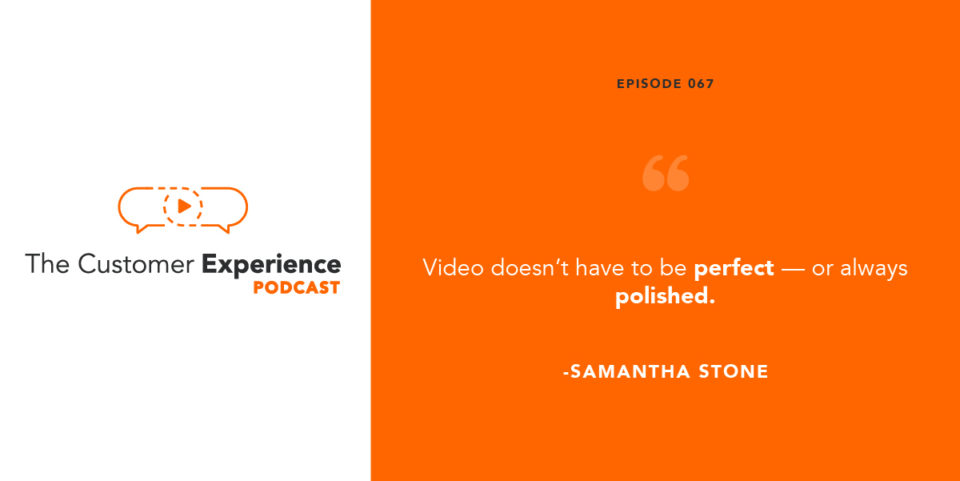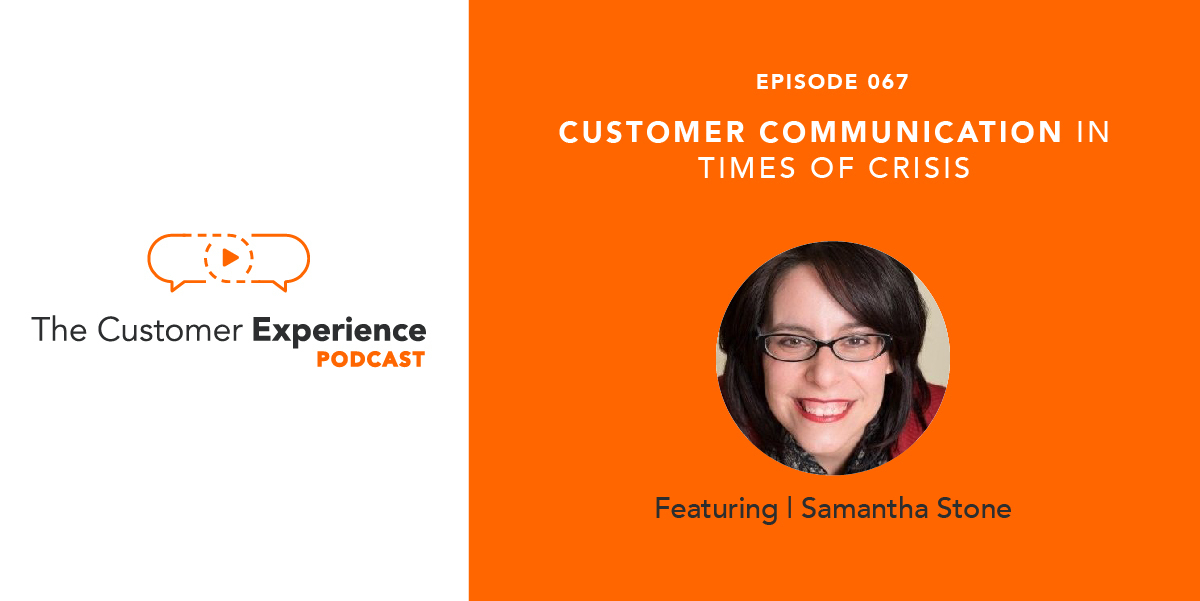
Listen to “67. Customer Communication In Times of Crisis w/ Samantha Stone” on Spreaker.
Apple Podcasts | Google Podcasts | Stitcher | Spotify
We’ve all been affected in one way or another by the COVID-19 pandemic – especially in how we communicate. Now, more than ever, digital communication (particularly video) gives us the power to stay connected while we’re physically separated.
That said, we should be practicing physical distancing, not social distancing. Yes, keeping a physical distance from one another is absolutely necessary right now to slow the spread of the novel Coronavirus. But we still need to maintain those social connections that are essential to the customer experience and to the human experience.
So, how should our interactions with customers change during a time of crisis? How should we adapt our use of customer communication channels — including the chat experience — to our new reality?
How do we show empathy in our customer communication? Because it’s obviously not “business as usual” right now.
To tackle these timely topics, we brought back our first return guest on The Customer Experience Podcast after more than 60 episodes … Samantha Stone.
She has vast experience in B2B marketing, product marketing, and marketing communication roles. And she brings this wealth of knowledge to this episode from a crisis communication perspective.
Samantha is the founder and CMO of The Marketing Advisory Network and the author of “Unleash Possible: A Marketing Playbook That Drives B2B Sales.”
Check out her first appearance on The Customer Experience Podcast in Episode 14: Balancing Automation, AI, and Human Relationships.
Throughout this conversation on Episode 67, you’ll hear about:
• How to tackle crisis communication (through the lens of the Coronavirus pandemic)
• When talking to a human is better than talking to a machine
• What proactive communication looks like and the proper default to set
• What chat research results mean for overall CX
• Why video doesn’t need to be perfect
Plus, hear very specifically how Samantha enjoyed success with video in the following clip…
Customer Communication in Times of Crisis
Hear the entire conversation with Samantha Stone right here:
Listen to “67. Customer Communication In Times of Crisis w/ Samantha Stone” on Spreaker.
Prefer to listen outside of this blog post?
Subscribe, listen, rate, and review The Customer Experience Podcast in your preferred player:

Full Transcript: Customer Communication In Times of Crisis
Ethan Beute:
When you’re 60 some episodes into a podcast, you’re still full of firsts. We’ve got a new first today. Our first return guest. After a variety of B2B marketing, product marketing and marketing communications roles, our guest founded the Marketing Advisory Network where she serves as CMO. She’s also the author of Unleash Possible, a marketing playbook that drives B2B sales. Her first appearance with us was on episode 14, which we titled Balancing Automation, Artificial Intelligence, and Human Relationships.
Ethan Beute:
She’s now back to talk about customer communication channels, including the chat experience, the power of video to keep us connected even when we’re physically separated, and generally crisis communication. All through the lens of the unique circumstances, we all find ourselves in with the coronavirus pandemic. Samantha Stone welcome back to The Customer Experience podcast.
Samantha Stone:
Well, I am so honored to be your first return guest. I have so enjoyed our conversation last time, and I’m looking forward to having another one again today.
Ethan Beute:
Just a quick note before… A couple things before we get going first, you do such a nice job of staying in touch. You were the, I guess, unintentional creator of the episode with David Meerman Scott by sending a copy of Fanocracy over. I hope folks check that one out too. Before we get into customer experience, I think let’s just set the scene a little bit. We’re recording this on March 16 of 2020. You’re in Massachusetts, I’m in Colorado, where are you right now with the corona virus COVID-19 situation?
Samantha Stone:
I’m glad you brought that up because we were talking about before the show, Ethan, I actually don’t think really we can talk about anything else. I think the reality is that when there are moments of crisis like we’re seeing today, and it’s widespread, it’s global. It’s affecting everybody. To pretend it’s normal course of business is just not realistic.
Samantha Stone:
People can’t think about what they might need in six months from now or 12 months from now. What they’re thinking about right now is what do I need tomorrow? Maybe what do I need this year. I’m happy to share very transparently opening a little bit about myself. I have a lung health condition. The lung health condition makes me extremely vulnerable to the COVID-19 disease and virus because of some of the injections that I take to treat that lung condition or suppress my immune system.
Samantha Stone:
In addition to that, should I get any respiratory infection, including this, I am likely to be one of those people who has a very severe reaction to that. What it’s like in my household right now, is a lot of precautions. My poor son made the mistake of ordering Burger King through Grub Hub, and here I am, “Before you open the door, tell them to leave it on the ground. You’ve already paid. Here’s gloves. Pick up the bag.” I’m really… We are… All joking aside we are being very cautious right now. But we are going outside. We are living in guests. We’re doing no travel, but we’re communicating.
Samantha Stone:
One of the great reasons I’m excited to be talking to you about this during this time is that video is a way that we’re staying connected not just at work, but also with family. I have a mother and father who drove back from Florida after several weeks away and because of their age, we’re not visiting with them right now. It’s really hard to not give my mom and dad a great big hug. But we do some video chatting that made us feel just a little bit better that we’re still connecting with each other.
Ethan Beute:
That’s good. Yeah, there is no substitute for real in-person connection and nice warm hugs. They will come again but it won’t be anytime very immediately. We did the same thing here. We still have… All the stores and restaurants are still open, although I know they’re closing down elsewhere. We’re all working remotely at BombBomb. Of course, all the events and everything are canceled.
Ethan Beute:
We’ll get into some of the consequences of that I think through the conversation. But one thing we did spin up within 36 hours of saying, yeah, that’s a good idea. Let’s do it. Is we started offering BombBomb absolutely free to all educators so that they could stay face to face with parents, students, peers and other people important to that process. As a parent whose son is hanging out at home right now, they just said two weeks, basically, they doubled spring break, and they’ll reassess. But there’s not a chance he’s going to go back to school physically in the next two weeks when this initial period is over.
Ethan Beute:
It’s a really interesting time. It’s highly fluid and as business operators and practitioners, I think we need to be as you, already offered, highly sensitive to where our customers and future customers are and where our employees are just in a headspace and in a legitimate, direct, immediate experience. Let’s get into and let’s start where we started last time. It’s where we always start here which is what thoughts do you have at a high level on customer experience? What does it mean to you? What are some of the characteristics?
Samantha Stone:
For me, customer experience, there’s a couple ways of looking at it. One way of looking at is a structural within an organization. What’s the team that’s responsible for creating an experience with the people that we sell to and that we serve. That is organizationally done in many different ways by different types of organizations.
Samantha Stone:
Fundamentally, what customer experience really means is it’s all the ways that we interact with people. It’s how they find out what we do and how they come to our website. It’s the tone of the conversations we have with them during a sales process. It’s when we deliver the service to them. Like me, I might go in and I might be running a workshop or I might be running a meeting. How I do that is part of the customer experience.
Samantha Stone:
If I’m selling them a physical item, how its packaged is part of the customer service. When there’s a problem, how we respond, it’s everything about how the people we serve, interact with us. That’s what customer experience is all about.
Ethan Beute:
I really like it. I think it’s a little bit trite or cliched to refer to Simon Sinek Start With Why, but you’re in that middle layer of how… and the second part of that in that how is something that is so much more difficult to replicate, or steal or mimic than the what? The what is very easy to mimic and the how I think is what is the first really good chunk of differentiation in the experience that we’re creating.
Ethan Beute:
You already said it’s not business as usual and it is not. It’s not life as usual either right now in the United States or anywhere else on the globe. Just to get it going, what are some of the implications that you see immediately from a business standpoint of social distancing and going remote and all the other consequences that we’re all experiencing right now?
Samantha Stone:
I’m glad that you asked that question because there’s a lot that’s going on. Some of the things that affect marketers, for example, are I got in my Facebook feed a person who was promoting an in-person event on March 24. No, just no. Stop. So that was really obviously mutual. Look, I could have chosen to just scroll on past that advertisement, not respond, but I actually had a really negative reaction to it. It felt very tone-deaf for me.
Samantha Stone:
I know that’s not the spirit. Technically they were targeting fewer than 25 people. They were abiding by the rule of law, but I didn’t feel like they had my best interest at heart. We as marketers have look at all the things that we do on a day to day basis and how we’re communicating and make sure we’re wearing a sensitive lens that acknowledges it.
Samantha Stone:
The other thing that we have to do is you have to realize that the way we serve our audience is going to change. If I am someone who works in an office, and I’m now working remotely, do I have appropriate call routing? For example, I have a friend who works for legal aid. She’s an amazing attorney who dedicates her life to service. I said to her, “Well just phone call people. Don’t show up to the hospital to meet them. What are you doing?” I get all this anxiety.
Samantha Stone:
She pointed out to me that she can work from home except the translation service that allows her to communicate with people whose English is not their first or dominant language is not working in her home phone. It only works at her office phone. So they’ll solve for that. They’ll fix that. But in all of our businesses, we have lots of things about what we do that we have to think about what happens when the people who can be remote, are remote.
Samantha Stone:
We also have to recognize that there’s lots of things that can’t be done from home. If you’re a first responder, if you’re a healthcare worker, if you are working for an essential city service, if you’re keeping our water and our power running. If you work in a grocery store, God bless you because you have this incredible difficult job in a stressful situation. We need our food supply chain to not be interrupted.
Samantha Stone:
We don’t think about all the stuff that has to happen there. We as leaders need to acknowledge the fear that people have around that, the concerns their family members have around that. We need to do what we can to protect them. For those of us who have a service that could maybe protect them, we should be making that readily available. We’ve seen some great things. You gave an example earlier of providing educators video access at no cost. We’ve seen other people make other kinds of conciliation.
Samantha Stone:
We also need to take care of security. The reality is when people are working more remotely or they’re working in more social distance situations, they are maybe not following all the secure protocols or filling… sending files back and forth in email. They’re throwing things on portable drives, and they’re exposing us. They don’t have the same networks and firewall. We need to make sure that we’re thinking about the infrastructure to protect the data of the people that we’re serving in this situation.
Samantha Stone:
The threat about all of this is simply using our good sense to think through the scenarios that our customers are going through, to be sensitive to how we communicate, and to be consistent and transparent about what we’re doing with our customers. Then on the flip side, we have to accept and be ready for an entourage of people who are trying to cancel reservations, reschedule meetings, transform whole conferences into virtual events who are just not sure how to make all these bits and pieces because we’ve never gone through something like this on a global scale.
Samantha Stone:
I’ve certainly done this in crisis management, for example, in New Orleans when we had those terrible hurricanes or we had flooding in Texas last year. But when we think about the scale of this, it’s unlike anything that we’ve done. We have to be ready to have questions that we don’t have time to answer be asked and we have to be patient with it. These are the times when talking to human is probably better than talking to a machine. Right?
Samantha Stone:
If I’m worried I need rubbing alcohol to clean my medical equipment. This came up on a Facebook group recently. Before I go to the store and I send somebody, they get my rubbing alcohol, I want to make sure it’s in stock and I call the store. I need to talk to someone who’s going to be able to tell me whether it’s in stock, tell me whether I’m going to be able to get it in stock. Maybe recommend places where we could have it be put on a waitlist. Whatever those things may be, and come together and interact with people in a way that is sensitive to…
Samantha Stone:
Even if we feel like business is normal because I’m sitting in the same office I sat in three weeks ago and six weeks ago. It’s not normal for the people who are calling me and asking me questions.
Ethan Beute:
Yeah really good. There’s a lot there. Couple things I want to touch on. One is, when you talk about transparency, a couple words came to mind there. It’s visibility and accessibility. All this stuff is up in the air. Is this two weeks? Is it a month? Is it eight weeks is a number that was just thrown out? It’s so so fluid. I think keeping communication channels open for our team members as we try to figure out what is something that we didn’t anticipate, we need to close this loop. We need to fix this.
Ethan Beute:
You gave a number of really good examples of just workflow issues that we need to pay attention to. Then you also teed up something that I spent a lot of time over the weekend doing, which is an undoing all of my travel plans. I have a high school junior at our home and we have a… He’s a school kid, loves school, high performer. We’re like, we had a bunch of college tours scheduled between now and next fall.
Ethan Beute:
We’ve been to a few schools already, but the first big trip here over spring break, of course, is canceled. We had to cancel personal plans, professional plans, et cetera. I found myself in a zone that I know you have a lot to recommend an offer around, which is the communication channels that are available to us as consumers. I was in emails, responding to some emails. I was in some mobile apps. I was on some websites, some was front-facing, some I was logged into my own account. I was on the telephone intermittently across these experiences.
Ethan Beute:
In one case, they took me from an email where to cancel they still wanted to charge me 50% of the charge. Then I called and they said, “Oh, okay, no problem at all. You don’t have to pay that. We’ll send you another email. Take a look at it.” This for a rental car, “Take a look at it and just reply and see what your circumstances are. Then we’ll just use that on file and then just cancel.”
Ethan Beute:
Well, turns out, it didn’t work out that way. At some point, I needed to call them back because their reply to my email which said, entire trip is canceled, the schools are not accepting us to visit the campus anymore. We were just not doing the trip. It’s not the prudent thing to do. We can’t even execute the whole reason we’re going in the first place. So we would like a refund. The reply was, well, there is not a national mandate not to travel. We can’t do that right now.
Samantha Stone:
This is like, be still my heart. Look, I’m sensitive and I understand that there are financially vulnerable companies out there that these changes impact. I believe that our government and our communities and our customers and our partners need to find a way to keep people solvent through this. Having said all of that, the answer and solution is not to piss off every customer. They shouldn’t even have made you ask the question of sending the emails.
Samantha Stone:
We are in lockdown as a globe right now across much of the world. Certainly across the United States and the campuses. Every college student right now is on forced break. My son tomorrow is going to empty his dorm because even though they haven’t officially said it’s going to be six or eight weeks. I think everything indicates it’s going to be and we don’t want to have to go back.
Samantha Stone:
If school reopens we’ll bring your stuff back. I like to have that problem but we’re going to go empty it. At least we can get his books and things for online learning. The right customer service and customer experience should just be to proactively communicate with you. We suspect your travel plans have changed. If we’re not correct, please let us know.
Samantha Stone:
The default should be the most likely scenario somebody is going through. They shouldn’t make you go through the hoop of saying why your plans have changed because we know the answer to that question. Your plants have changed because everything is in a slowdown mode as we as a country respond. Now, I don’t blame the individual person who had to read that email. Clearly they haven’t been given a corporate policy that gives them the fortitude to address that.
Samantha Stone:
They could have a policy that says at this point, we actually can’t afford to do refunds and maybe we’re not in a financial situation to do that. They should at least give you a credit towards future. Or they should have some dialogue with you about that situation but they defaulted wrong. They asked you to jump through hoops incorrectly. They have a policy that’s going to make you uncomfortable and unsatisfied with it.
Samantha Stone:
Instead of delivering bad news to you in a conversation where at least the empathy can come through, they didn’t do it. For example, I canceled my housekeeper. Let me tell you, this was a painful decision for me to make. I’m in a situation where I could afford to pay her. I said that I’m going to just Venmo you the money at least for a couple of times. She’s an individual and I’m fortunate and grateful to be able to say that I can afford that.
Samantha Stone:
But if I had to call and cancel, I wouldn’t have sent her a text message saying I’m canceling and I’m sorry, I can’t pay you. I would have picked up the phone and at a minimum left a voicemail where she can hear my voice and hear my sincerity and understand that I feel bad about it. We can’t always do the thing that’s going to make the customer on the other side happy, but we can do the thing that makes them feel we’re human and empathetic to the situation we find ourselves in.
Ethan Beute:
Yeah, just allow them to feel like they’ve been heard and that they’re appreciated. I see you, I understand your circumstance, I want to meet you there. Let’s talk about what we can do. I thought the airlines, in general, did a very nice job of the two things you specifically recommended, which is default to what is the most likely situation. Which by the way, this applies at all times, not just in times of crisis, but default to what the expectation is, and then make it really easy.
Ethan Beute:
All of them are… Hey, and I forget which one because I had flight scheduled. I’m United guy on points mostly, because they fly out of Colorado Springs. I had flights on Delta and American also scheduled just so I could go direct out to Colorado Springs, which is not a major airport. I mix up my vendors, and they all did a really nice job of proactive communication. I forget which one it was, but they said, “Hey, don’t call us. Here’s the deal. You have no obligations right now. You have up until the end of the year to reschedule the value of this flight.”
Ethan Beute:
They’re like… It’s really this whole flatten the curve thing but in a very acute customer service situation. Is like, don’t call us right now. You’re going to hate it, we’re going to hate it. We got your back. Don’t worry about it. You have months to figure it out. What now I need to do is make a little spreadsheet to say all the flights I canceled in a little open credit because they’re spread across various apps and websites. They did both of those things really well.
Samantha Stone:
That’s a perfect example of how to use technology because what they needed to free up their staff for was the person who says my son is stuck in London and I need to get my kid home. Help me do that. Look, technology can help us communicate to the default step and they made it very easy and very empathetic so that when the things that are emotional, things that I need to respond to, I can make sure that my phone staff is available for them to be able to.
Samantha Stone:
I agree. I think the airlines overall have done a nice job. My son reluctantly was on a flight this week. It was a short domestic flight from Rochester. I was really uncomfortable situation but I needed to get him home. I was comforted by talking to the airline about the cleaning thing. Sure I got the email everybody else got, but given my scenario, I also called the local airport and I asked them to give me the lay of the land and I felt they were honest and sincere and well trained, because we could have had the option of him renting a car and driving back or something like that.
Samantha Stone:
It’s a… I think you’re right. There is so much good happening right now and so much that I’ve actually been pleasantly surprised by but there have been pockets of opportunists that are feeding in to the frenzy and the fear and the discomfort or just making us go through a whole bunch of extra hoops. Nobody needs the extra stress right now. Let’s make it easier on ourselves.
Ethan Beute:
Yes, let’s talk about one of the channels that I know you have some thoughts on, which is chat. We have two ways to go about that, live chat and chat bots. Last time we talked, we talked about the transparency of automation and AI, although a lot of cover ground Episode 14, go back and listen to it. It’s really good. We won’t do too much of it again, but this idea that so much of what we’re calling AI is actually automation.
Ethan Beute:
In these channels, you don’t have what you have on the phone or even what you have with videos, this empathetic thing. We talked about transparency and not acting as if you’re a person, if you’re actually a bot. But in this context of our conversation here today, what do you think about the chat experience today as regards the customer experience?
Samantha Stone:
First of all, I think the chats that are live and AI-driven are part of the toolkit that we should be using. I think they’re incredibly useful. I did a study where we talked to… About 550 I think is where the number ended up but over 500 consumers. We very specifically asked them when they want to talk to machine, when they don’t. What their expectations are? We gave them scenarios and asked them to say if you read these three scenarios, how would it change? Would you buy from that person again? What do you think about their brand?
Samantha Stone:
It was startlingly clear, for everyday operational things, talking to a machine instead of a person is perfectly fine and often preferred. I want to know if you’re open. I want to know you know what’s the balance on of account? What time is that appointment I scheduled again? I don’t actually need to have a back and forth. I want to ask a question and get it answered.
Samantha Stone:
When I have a moment of concern, upset, frustration, do not give me to a machine. It actually makes it significantly worse. It doesn’t just make it significantly worse in the moment that I’m in right now. It makes me not want to interact with your brand prior. The other thing that it surfaced very clearly is, don’t pretend you’re human if you’re a machine because when we get into scenarios where I can tell that…
Samantha Stone:
The same bad chat experience that was clearly a little robot symbol and not a real person, it looked like a picture of a person. The same exact chat script was way more negatively perceived in the long term relationship I want to have with the brand when I thought it was a human or pretending to be a human than when you were just clear that’s a robot. I forgive the robots ignorance because it’s a robot and I’m okay with that forgiveness.
Samantha Stone:
It also became very clear we need escalation patterns. Particularly in scenarios like this, where we all have questions. You’re running around trying to figure out how I’m going to respond to events being canceled and I’m trying to figure out where I’m supposed to be or get home from wherever I am or adjust a meeting from wherever I am. When I hit a stuck point, I need to be able to talk to an actual human being. Our automated technology needs ways to identify that I’m getting that point.
Samantha Stone:
When we put that chatbot up, and we simply say, here, have a… Here’s the phone number to call. It’s one of the most frustrating things that can happen because you’re asking me to leave the medium I chose to use, in this case a chat window and go find my phone, dial a number and rig it in a queue for somebody to answer my phone call. Even if the phone call resolves my issue, we’ve created extra steps for someone at a moment that’s the worst time to create extra work for them.
Ethan Beute:
Yeah, putting the burden on the customer, even the perceived burden. In some cases really not that much more work but if it feels that way, the customers experience is the experience. The customer’s experience is a matter of fact, we need to respect it and appreciate it. In this channel switching situation, I did a solo episode just based on some of the learnings of the first chapter of the effortless experience by Matt Dixon and a couple other folks.
Ethan Beute:
Being treated like a number and channel switching are two of the most frustrating things people can experience. Really interesting survey results by the way. I love that you’re just doing that work. In unleash possible, you advocated for video extensively. I forget which chapter it was somewhere toward the end. Of course, we already touched on it a little bit here and I think what it does is takes a little bit of that, what we’re talking about.
Ethan Beute:
The empathy that can be delivered through a voicemail or through a phone call and just steps it up to another level that if we are sincere in our message, whether it’s I’m really sorry for your experience, or I’m so excited for you, or congratulations, you just hit a milestone. Whatever the message is, that if we’re sincere in it, that our bodies and our faces and our voices all tell it in a way that just simply can’t be communicated any better except live in person.
Ethan Beute:
In light of our conversation here, maybe set up your initial ideas about video. Whether as expressed in Unleash Possible or since you wrote the book, and in the context of what we’re talking about here today.
Samantha Stone:
I really believe that video is critically important because not only can you better see how I’m responding to something or I project my surprise, my sincere apology, my excitement, my information. But equally as a person, I can see the other person on the other side and I can read their body language and I can respond and adjust to what I’m seeing on the screen just like if I was in a room with the person. It’s a little bit different, but it proxies it very well.
Samantha Stone:
I think video is critically valuable tool and we use it in one on one conversations. I by default turn my camera on for pretty much every conversation. There’s a couple exceptions. Sometimes bandwidth is an issue for a day or a moment and that’s fine. I do a podcast that’s audio-only because that medium is meant for someone while they’re doing something else like driving and that’s okay.
Samantha Stone:
But my default is video on. We also have to remember that video is a really powerful tool for all different kinds of content. Long-form content, teaching something, interacting with someone. It’s a great tool for direct mail to open something up and actually have video welcome message instead of just another message. There’s just a whole bunch of things that happen.
Samantha Stone:
One of the things we have to remember and remind ourselves of is that video doesn’t have to be perfect. It doesn’t have to be always polished. I have on a scarf and I threw some lipstick on because I love you Ethan and I knew you were going to be videotaping me. But I’m still comfortable and I’m still not overly prepped. I didn’t have hair and makeup come in and do this today.
Samantha Stone:
I don’t need to because the whole point of video is actually to make people comfortable with each other. It is a unique medium by which we can do that. If you are not yourself on the video, whether it’s a direct mail piece you’re sending out, whether it’s a little note from a salesperson whether it’s a high five to somebody who did a great job, it doesn’t matter. We just got to get good at being comfortable.
Samantha Stone:
I’m always thinking about what can I do for video, I’ll give you a really good example of how I use video to affect a business outcome for myself actually not that long ago. We ran a marketing strategy workshop, my business partner and I. It was the first in person workshops that we’ve done for a classroom setting. We run workshops for individual clients all the time. I’ve taught big workshops at conferences that other people have hosted off and off.
Samantha Stone:
It was the first time that we’d done it. We assumed the math that half the people who registered wouldn’t show up. Typical event type of thing that happened. But I was determined to break that trend. If I think the thing that gives us the most… It was a good class. I’ll say that and I think people wanted to come. We had a good venue and we had good material. We did all of that but even when you do that you still have drop off.
Samantha Stone:
What we did is as soon as somebody registered, I sent a video message to them that said, “Hey, congratulations. So excited you came. Here’s what to expect for the day. You don’t need to prep.” It’s like, if they don’t show up, they’ve disappointed me a little bit. Then, the day before the event, we said, “Hey, can’t wait to see you tomorrow.” And gave some other little stuff.
Samantha Stone:
I think we ended up having 20 people registered. One person got called away on an out of town trip last minute for an urgent work and couldn’t show up. Every other… And they sent this hugely apologetic, I can’t be there note. Every other person came and came on time and stayed the entire time. We’re good but it’s not just because we did a good workshop, we took the time to connect with people who had registered in this very intimate way. I really truly believe that the video played an important role in getting that show rate to be higher than it might otherwise have been.
Ethan Beute:
It’s really good. The social reciprocity piece is a really good one and an undervalued one, but you referred to it twice. The first one is this idea that they’re not just letting down some organization that has an email signature and some details and a typed out email. They’re letting down Samantha. I can’t let her down. In the case that I have to, this is the second part, I’m going to be profusely apologetic. Whereas otherwise, it’s just so much more difficult to disappoint or reject a human than it is a wall of faceless digital text.
Ethan Beute:
We’ve seen this too by the way. Using video to increase show rates on appointment set, demos set, these other things. Not just a full-day workshop, but even lighter weight stuff. Even zoom calls and those types of things. We have a pretty large… One of the top 10 franchises in the United States. Their franchise sales team uses BombBomb. They were able to increase show rates from 56 to 78%. On one of their initial calls. You just like walk that out. Just think about a traditional sales funnel generically speaking.
Ethan Beute:
The ability to take the initial conversation and set the appointment is one thing and then to actually have the appointment show and to be able to bump by 20 plus points, the show rates on that call. Just think about all the downstream consequences and all it is what we’ve already observed, which is… It’s just human connection. It’s just this, yeah I can’t let her down or I feel more connected or I feel more trust toward the situation. I feel more clear about what to expect because it’s been communicated to me. Not through my own tone of reading this otherwise toneless text.
Ethan Beute:
I mean, a really good writer can infuse text with a little bit of tone that people can feel not just read and think but actually feel. Video, you just start feeling immediately.
Samantha Stone:
That’s a perfect example of how to apply this at scale. That’s a huge difference in your business. Think about that. A 20% plus swing and the people who show up for demo. That’s big. I do think social reciprocity as we’ve been talking about is part of it. I also think it shows… It’s going to be worth my time because they’re saying things that are relevant.
Samantha Stone:
I’m likely to maybe skip through and read an email like logistics update. I probably scan. I also send texts by the way because not everybody watches video. So we did that. But also, I think there’s this component of, I’m important. They took time to send me a message. I’m important to them. Therefore there’s a piece of this. I’m going to want to go there. I’m going to want to see this. It’s going to be worth my time. They’re articulate, they have something relevant for me.
Samantha Stone:
I love the application of applying to show rates for demos. I think it can be used for all kinds of things. Ethan is the best at this. Every conversation with Ethan, big milestone, he always sends the most Gracious of videos afterwards out and is a real living example of how to build that connection with people that we may never have been in a room with before. But I can still feel like it, right?
Ethan Beute:
Yeah. I appreciate you saying that. A really good point, this gift of your time and attention is something that can’t be fake. No one knows how long it took you to write that email but everyone knows that you spent 42 seconds explaining that thing just for you. You can do evergreen or you can do truly personal. Do it truly personal that is just the ultimate. This gift of my time and attention.
Ethan Beute:
No one’s going to say that consciously and say, “My gosh, she took 42 seconds out of her day to say that.” But I do get all the time, thank you so much for taking the time to answer my question in a video. It’s like, I just saved myself five or 10 minutes. It would have taken me a lot longer to explain it by typing it all out. There’s a number of really good benefits there.
Ethan Beute:
At the risk of time and at the risk of throwing a complete curveball into the conversation, it was recently… I’m going to do it anyway.
Samantha Stone:
This is why I love you, Ethan. Do it.
Ethan Beute:
Good. It was recently International Women’s Day and on LinkedIn, you gave a shout out to several women that you’ve worked with and really respect. You helped give away some free subscriptions to Innovation Women. I just wanted a quick take from you on as someone who has obviously built a successful career as a woman. Why in 2020 are we still in this gender inequality situation?
Ethan Beute:
What are some seeds of hope? Just give me a quick take on what’s the scene and where are we going and what are you encouraged by?
Samantha Stone:
I wish I could tell you why we’re still in this situation because the reality is in my entire lifetime, laws have been in effect to make this relatively easy in parts of the world that I work. That is not true in large parts of the world. There are still real inequalities in legal structure in the rights that a woman has versus a man in big parts of the world.
Samantha Stone:
Part of what holds women back is cultural and legal context that we take for granted in the United States and in a lot of European countries and many places around the world. We just take it for granted they exist. They don’t in many places. So that’s a fundamental infrastructure that needs to be fixed.
Samantha Stone:
More day to day operationally oriented. I think we don’t do a good job of rewarding people have different approaches to solving things. I’ll be quite candid. As a woman, I quickly got promoted in my career and I quickly had success. I didn’t hit a lot of direct glass ceilings, but I believe there’s a real reason for it. I believe the reason for it is I acted like a man.
Samantha Stone:
I did the things in the environment and not all men act the same. Everybody don’t interpret that. What I mean was I was really assertive about what I wanted. I was super aggressive about forcing myself into conversations. I’m not known for sitting back and being quiet. That makes me a strong woman but does it make me every woman? There are strong women like that.
Samantha Stone:
We as communities and as business leaders need to get back to listen to all voices, including quieter voices. I think there’s inequality not just in men and women. I think there’s inequality and a whole bunch of contexts around different thought process and different things. But the female versus male inequality is robust and consistent because all of the infrastructure to address it isn’t there. We’re not taught the same things. We’re not supported in the same way and it’s real. It exists today.
Samantha Stone:
I do have hope. I personally have had a very wonderful journey but it hasn’t always been easy. I’ve had to… I’ve been a working mother with young children. The first day I started a job, the president of the company looked at me and said, “I did not want to hire you.” They didn’t want to not hire me because of my skills or my experience. I was a perfect fit. They didn’t want to hire me because I had an infant and I lived 45 minutes from the office that we were required to be in. They were worried that I would have to leave to pick up my kid at daycare.
Samantha Stone:
Literally, that’s the exact conversation we had. That should not have been a conversation. Now I was very fortunate. We made a decision as a family. My husband chose to stay home with our kids. He took the child care issue off the table for this particular organization, but I shouldn’t have had to… It was the right choice for our family anyways. But a lot of people don’t have a choice to make, or they make that choice because they feel like they have to.
Samantha Stone:
I think just fundamentally, inequity still exists. We have to take an active stand to change that. Days like International Women’s Day gives us the opportunity to surface those challenges and to move forward and correct them. I love seeing all these programs that are designed to elevate female voices. I love seeing more young girls follow pursuits and sciences and math and other things that have traditionally been very male-dominated.
Samantha Stone:
Quite frankly, it’s not just the right thing to do, we have to do it. I’ll give you a really real example. We have artificial intelligence technology that is building algorithms that fundamentally decides what we see, what we don’t, who we target, who we don’t. If a woman’s perspective, and the only people who are coding that are men, and it’s only trained on it, they will inherently miss things about a half of the world’s population.
Samantha Stone:
Just like if it’s all young people versus old people, or if it’s all people of one culture versus a different culture. We have to have that diversity. If we don’t do things to encourage young women to move into the sciences, we’re going to find ourselves in some very tricky and dangerous situations that are not because people are evil. It’s just because we all have the context that we have.
Samantha Stone:
I am excited and I am optimistic because the fact that we’re even having this conversation Ethan, would never have happened 20 years ago in any of my conversations. I see that as a positive sign, but there’s still a lot of work to do.
Ethan Beute:
Good. I’m really glad that I asked. I think a couple things. See something, say something. I think that’s one way that anyone listening to this in a workplace environment can start to make the cultural change. It’s one thing for that gentleman that you were referring to earlier to think these things, but to see it openly, say something about the culture inside that organization. When you see something borderline or obviously inappropriate, just say something. Question the person who said it, question the person who did it. Just make them think twice to create this awareness. Doesn’t have to be highly confrontational.
Ethan Beute:
But letting things fly, we’re all complicit in the consequences of letting things fly. I do think that just the general awareness of… I mean, it’s hard because it’s unconscious bias and so making the unconscious conscious, is a little bit oxymoronic or a contradiction in terms or something. But the more aware that we are, the better off we are. I am going to… Even though you already did this once, you thank Jeff Holling for opening up an early stage of your career in a really welcoming way.
Ethan Beute:
You gave a shout out to the Hyatt at B2B MX for accommodating your health condition that you described at the top of this conversation. In just a minute, I’m going to ask you to answer both of those questions again, because it’s been 10 months since we’ve talked.
Samantha Stone:
Got it.
Ethan Beute:
But before we do, for folks who are listening, again, be sure to give a listen to Episode 14 “Balancing Automation, AI and Human Relationships” with Samantha. If you want, check out Episode 63, creating fans through human connection with David Meerman Scott. Again, one of the reasons that… I mean, it was not this transactional but this is the way that just being thoughtful and gracious works out.
Ethan Beute:
You were kind enough to think of me when his book Fanocracy released, you had a signed copy sent to me and I was like, I like her. You just reminded me, I need to talk to her again. We had been in communication anyway. But anyway, Episode 14 and Episode 63. If you enjoyed this one, you’ll like that one too. Samantha as we wind down, take a minute here to thank or mention someone who’s had a positive impact on your life or your career.
Samantha Stone:
Oh gosh, I’m so fortunate. There have been so many amazing and wonderful people. I won’t thank Jeff Howe again-
Ethan Beute:
Howe, sorry.
Samantha Stone:
… just because we’ll spread… That’s okay. We’ll spread the love a little bit around that. One of the people that I’d love to recognize is Katie Martel. I’m not sure that she would think of herself in this way. If you care a lot about equality for women or truth in advertising in general, a lot of things. Katie does some amazing work around pandering and cause marketing and calls out a lot of companies who do it wrong.
Samantha Stone:
She also happened to edit my book. She also happens to be a person that I’ve been fortunate to know for a lot of years. I really have to give her credit because she makes me want to be a better marketer every day. She is the voice that we need out in the world. It’s easy to turn things pink on International Women’s Day. That probably isn’t going to serve your business well.
Samantha Stone:
She holds us all accountable and I think we need more of Katie Martel’s in the world. I’m really deeply grateful for her inspiration, but also very practically for her help. I’m not sure that Unleash Possible could have ever happened without Katie. She and I… She kept me honest, she kept me true to what I wanted to say. She knew me well enough to know when I was going astray from my purpose and pulled me back. Anybody that can make you look smart and talented deserves a big high five and she certainly gets a shout out from me for that.
Ethan Beute:
Awesome and we are all fortunate if we have one or more people in our lives that make us want to be better today than we were yesterday? Just to get that… I have that inside me, but to get that support is so helpful for other people. I love hearing you describe her as someone who makes you want to be a better marketer. How about a company that you really respect for the experience that they deliver for you as a customer?
Samantha Stone:
That’s an excellent question. I’ve had some really good experiences recently. I’ve had some really bad experiences recently. I’ll give you one of the examples that I like to use because I think it really is demonstrating of a commitment this company had made to their customers, Wayfair. I ordered chairs from my office when my office was coming in. I was being a little obsessive about everything because this was a brand new workspace for me and I wanted everything to be perfect.
Samantha Stone:
The chairs came and I didn’t love them. They didn’t look the way I thought they would and I was super disappointed in them. They looked a little damaged. I called up Wayfair and I’m prepared to go to battle over why I need to return these chairs and I want different chairs. Not only did they graciously with no hesitation, say no problem. We’ll take back the chairs. I’m sorry you have that experience. You were looking at these other chair designs that are very similar that were out of stock. Would you actually like those instead of maybe replacing the one that looked a little damaged when I got it?
Samantha Stone:
I’m like yes. Got through all this and I’m excited and I’m like, okay, so how exactly do I box these back up and get them to… It’s a chair, I’m not going to stuff it in an envelope and take it to Kohl’s to be returned like I might do with some of my Amazon things. They’re like, nope, you got someplace you can donate them? I’m sure I can find and donate. They’re like keep the chairs, donate them.
Samantha Stone:
They made the whole experience positive for me. Not only did I get replacement chairs that I’m in love with and I just adore, they also let me keep the old chairs and not have the hassle of returning them. I got to donate them to something that I feel good about. All of this stuff came together in a way that I think is wonderful. I will say that I think Wayfair’s phone service has this care.
Samantha Stone:
I don’t think they’ve translated it well to their email services and their chat services. So I caution that experience with them. But on the phone, their team is phenomenal and I really value and I keep shopping there knowing that I’m going to be able to have this positive experience should another issue arise. Which doesn’t… Most of the things I buy are great, but occasionally it does happen and I know they’re going to take care of me.
Ethan Beute:
It’s really good. I can’t imagine, I always worry about that. Even on a much smaller. I mean, you referenced that. I worry about that with a smaller thing like should I save this box? It’s got a one year warranty. I live in a very small house. So saving boxes so that I can re-box something is not on the top of our list. It’s like straight to recycling. Anyway, I love what they did for you there.
Ethan Beute:
Samantha, this has been great. I wish you good health and continued success, especially through this really interesting and odd window that we’re in. If folks want to catch up with you, or they want to check out Unleash Possible or anything else where will you send people to follow up on this conversation?
Samantha Stone:
Yeah, thank you. I’m going to give you that information. But I want to say one thing before we wrap up. I hope you don’t mind Ethan.
Ethan Beute:
Please.
Samantha Stone:
As we’re going through this amazing point of uncertainty, we don’t have all the answers to all the questions that are going to be asked of us and that we’re going to ask ourselves. The right thing to do here is just acknowledge the uncertainty, be as open and transparent as you can be. Don’t share false information and don’t make promises you can’t keep. This is a really hard one. Don’t say we’re going to do something that we’re not certain that we can do.
Samantha Stone:
It’s okay to say I don’t know. It’s okay to say we’re going to try. I’ve been using a lot of those positive communication so please do that. I love for new readers of Unleash Possible. Every week I get new messages from people with information and comments and questions and there’s nothing more rewarding than that. Unleash Possible is available on Amazon, both as an audiobook as well as a regular good old fashioned physical book which I like still the touch and feel.
Samantha Stone:
Ethan’s got the copy there which I love. Paul Smith, my narrator did an amazing job narrating for me. Even one little sentence about being pregnant, which that’s a whole nother story and we can talk about another time. If you’d like to get a hold of me, please do. I’m on LinkedIn. I’m on Twitter. It’s Samantha Stone. Readily accessible, my email address is samantha.stone@marketingadvisorynetwork.com. I give that out freely because I want people to reach out and ask questions. There’s just nothing better than helping your ideas come to life in a particular organization. Look forward to meeting all your listeners.
Ethan Beute:
Awesome, it’s funny I used to be a little bit tentative about giving up my email address I guess in conversations like these and then you realize, someone A, if they made it this far they’re obviously into it. B, if they’re really into it I want to talk to them. It’s a privilege. Anyway, you can also reach me Ethan E-T-H-A-N@bombom.com. Hit me up on LinkedIn, Ethan Beute.
Ethan Beute:
Everything that Samantha just said I will include. I write up these episodes at bombbomb.com/podcast. I also drop in some video clips. I know there were some visual moments in this. I’ll do my best to try to find those and include them just to bring the episodes to life. I appreciate everyone for listening. Samantha, I appreciate your time so much today.
Samantha Stone:
Yeah, thank you so much and hey, if you do nothing else but connect a still that doesn’t show me up my nose or something. I’ll be happy. I don’t know what it is but everybody collects that one thumbnail that you don’t want. But thank you to your listeners for listening. This is a time of uncertainty and I’m so grateful to have a collaboration with you to talk about and just acknowledge it. And to remind us all that this is about human connection, video can play a very important role for us as we’re going through these moments, weeks, possibly months of uncertainty and come together as a community.
Ethan Beute:
Well said.
Video Highlights: Customer Communication In Times of Crisis
Check out the top five video highlights from the discussion with Samantha below…
1. Coronavirus and Customer Communication
2. When Customers Want to Talk to a Human
3. Proactivity Customer Communication and The Proper Default
4. Chat Research Results and What They Mean for CX
5. Embracing Video Imperfection
Other CX Conversations You’ll Enjoy:
- “Balancing Automation, AI, and Human Relationships” with Samantha Stone (founder and CMO, The Marketing Advisory Network )
- “Creating Fans Through Human Connection” with David Meerman Scott (bestselling author of 11 books including “Fanocracy”)
- “Two Keys to Creating ‘Extraordinary’ Customer Experience” with Dan Gingiss (customer experience and social media expert)
Please Subscribe to and Rate The Customer Experience Podcast:







